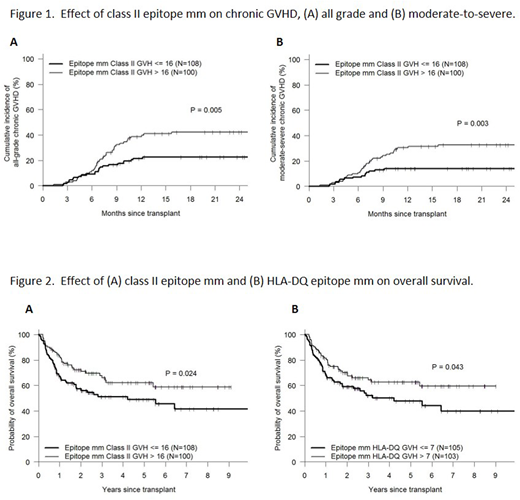Abstract
Post-transplant cyclophosphamide (PTCy) has improved the outcomes and expanded the use of haploidentical hematopoietic cell transplantation (haplo-HCT). Unlike many other allogeneic HCT settings, the impact of HLA disparity on graft-versus-host disease (GVHD) and transplant outcome in this setting remains unclear. HLAMatchmaker is a computer algorithm that assesses HLA compatibility at the structural level by determining what and how many functional epitopes (eplets), defined as patches of polymorphic residues within a radius of 3.0-3.5 Ångstroms, are shared between donor and recipient. It has been useful in the identification of acceptable mismatches (mm) for alloimmunized kidney transplant candidates. In order to determine the effects of HLA class I (HLA-A, B, C) and II (HLA-DR, DQ, DP) epitope mm on transplant outcome, we retrospectively analyzed 208 consecutive donor-recipient pairs receiving haplo-HCT with PTCy for hematologic malignancy. The impact of epitope mm (GVH direction) on GVHD and survival endpoints was evaluated by Cox multivariate analysis (MVA), controlling for other significant patient, donor and transplant-related factors. Median (range) recipient and donor age was 52 (19-75) and 38 (15-73) years respectively. Patients were transplanted for AML (34%), MDS/MPS/CML (20%), ALL (17%), NHL/HD/CLL (25%). PBSC was used as the stem cell source in 66% of patients, and conditioning intensity was myeloablative in 41%. The donor was a child, sibling, or parent in 47%, 38%, and 14% respectively. Median (range) follow-up for surviving patients was 33 (7-130) months. HLA class I epitope mm had no effect on GVHD or survival. In contrast, increased HLA class II epitope mm (>16) was significantly correlated to an increased frequency of chronic GVHD (figure 1). In MVA, higher degree of class II epitope mm was associated with chronic GVHD, total (HR 1.91, p=0.012) and moderate-to-severe (HR 2.37, p=0.006). The positive effect of increased class II epitope mm on chronic GVHD was driven mostly by HLA-DQ epitope mm (HR 1.7 for >7 vs. ≤7, p=0.047) with a non-significant contribution from HLA-DP (HR 1.36 for >2 vs. ≤2, p=0.24). In contrast, increased HLA-DR epitope mm had a protective effect on chronic GVHD (HR 0.52 for >7 vs. ≤7, p=0.021). Epitope mm was not significantly associated with acute GVHD, grade 2-4 or 3-4. There was also no effect of allele-level mm at any HLA loci on acute or chronic GVHD. We next tested the impact of class I and II epitope mm on survival, including the individual impact of HLA-DR, -DQ and -DP epitope mm. Although class I epitope mm had no impact in univariate analysis, a higher number of class II epitope mm (>16) was correlated with better overall survival and the effect was primarily driven by HLA-DQ epitope mm (figure 2). To better assess the impact of class II epitope mm on survival, we analyzed this variable in the context of a previously published MVA (Solomon et al. Biol Blood Marrow Transplant. 2018;24:789-798). Controlling for other significant variables (age, race, CMV status, donor relationship, HLA-DR mm, nonpermissive HLA-DP mm, KIR receptor-ligand mm and KIR haplotype), only increased HLA-DQ epitope mm (>7) was independently associated with decreased non-relapse (HR 0.34, p=0.021) and overall mortality (HR 0.60, p=0.039). These results indicate a significant effect of class II epitope mm on chronic GVHD and survival following haplo-HCT with PTCy. Higher level of class II epitope mm and HLA-DQ epitope mm is associated with increased chronic GVHD incidence, whereas HLA-DR epitope mm is protective. Higher HLA-DQ epitope mm is independently associated with better survival, when controlling for the presence of HLA-DR allele-level mm or a nonpermissive HLA-DP mm, which have been shown previously to improve survival. Class II HLA epitope level matching provides important prognostic information in the setting of haplo-HCT and PTCy, which is not reflected by conventional allele-level matching.
Solh:Amgen: Speakers Bureau; Celgene: Speakers Bureau; ADC Therapeutics: Research Funding.
Author notes
Asterisk with author names denotes non-ASH members.


This feature is available to Subscribers Only
Sign In or Create an Account Close Modal